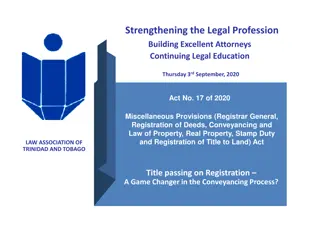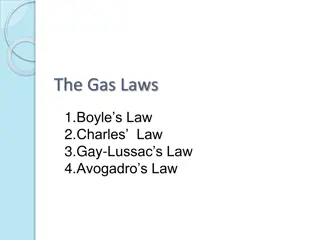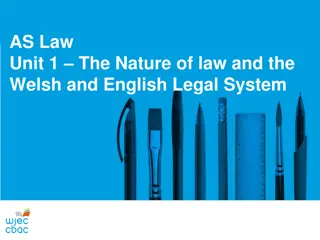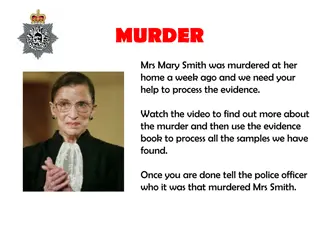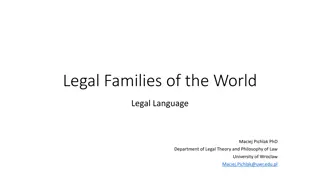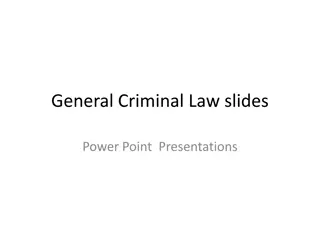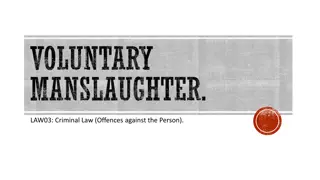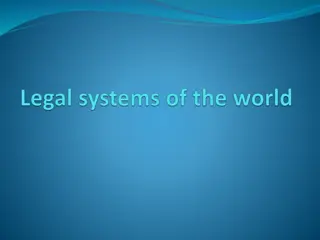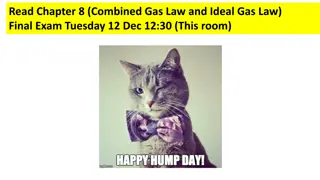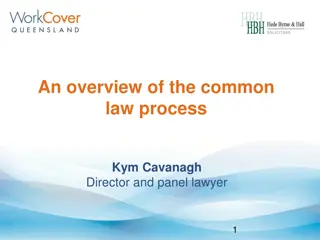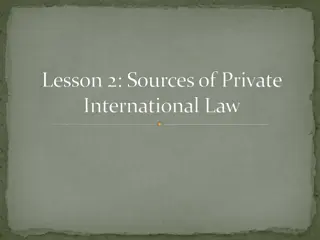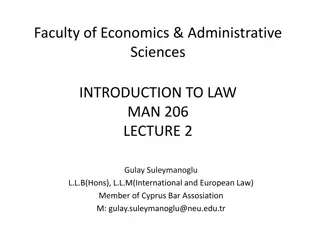Murder in Common Law
Murder, as defined in common law, is the unlawful killing of a human being with malice aforethought. This act involves both actus reus (unlawful killing caused by the defendant) and mens rea (intention to kill or cause grievous bodily harm). Legal causation, including thin skull test, chain of causation, and original injury as the substantial cause, plays a crucial role in determining culpability. Various case laws and principles like the Queen's Peace, Year and a Day Rule, and the But-for test contribute to the complex nature of murder under common law.
Download Presentation

Please find below an Image/Link to download the presentation.
The content on the website is provided AS IS for your information and personal use only. It may not be sold, licensed, or shared on other websites without obtaining consent from the author.If you encounter any issues during the download, it is possible that the publisher has removed the file from their server.
You are allowed to download the files provided on this website for personal or commercial use, subject to the condition that they are used lawfully. All files are the property of their respective owners.
The content on the website is provided AS IS for your information and personal use only. It may not be sold, licensed, or shared on other websites without obtaining consent from the author.
E N D
Presentation Transcript
Definition Common law offence Lord Coke s definition: the unlawful killing of a human being under the Queen s Peace with malice aforethought. Also requirement that death occur within a year and a day.
Definition Human being AG s Reference (No 3 of 1994) (1994) Death R v Malcherek and Steel (1981). Considered to be when person is brain dead but this was stated obiter. Courts will decide on a case by case basis. Queen s Peace Year and a day Law Reform (Year and a Day Rule) Act 1996.
Actus Reus Unlawful killing Can be an act or an omission - Gibbins v Proctor (1918). Defendant must have caused the death - Prosecution must prove the defendant s act caused the death. - Must establish causation in BOTH fact and law - referred to as factual and legal causation.
Factual Causation But for test - But for the actions of the defendant the victim would not have died as and when they did. - White (1910). De minimis rule - Defendant s actions must have been more than just a minimal cause of the death.
Legal Causation Thin skull test - Defendant must take the victim as they find them - Blaue (1975). Chain of causation Must be a clear link between the actions of the defendant and the victim s death. Intervening acts may break the chain of causation. Pagett (1983).
Legal Causation Original injury must be an operative and substantial cause of the death. - Negligent medical treatment is rarely sufficient to break the chain of causation. - Smith (1959). - Cheshire (1991). - Jordan (1956). Switching of a life support machine will not break chain of causation Malcherek (1981).
Mens Rea Malice aforethought. Now known as an intention to killorintention to cause grievous bodily harm. Can be either express or implied. Vickers (1957) A person can be guilty of murder even though they did not intend to kill. Vickers broke into a sweet shop, he knew that the owner, an old lady, was deaf, however she came in and saw Vickers, who punched her and kicked her once in the head, she died from her injuries. The Court of Appeal upheld Vickers conviction for murder; where a defendant intends to inflict grievous bodily harm and the victim dies, this is sufficient to imply malice aforethought The same point was considered in Cunningham Cunningham (1981) The defendant attached the victim repeatedly with a chair in a pub, the victim died and the defendant was convicted of murder, his appeal was dismissed by the House of Lords an intention to cause grievous bodily harm was sufficient for the mens rea for murder
Indirect/ Oblique Intent Foresight of consequences. Moloney (1985). Lord Bridge s direction to jury: Was death or really serious injury a natural consequence of the defendant s act? Did the defendant foresee that consequence as being a natural result of his act? Direction has been criticised: Lord Bridge did not refer to the word probable which is in the Criminal Justice Act 1967.
Mens Rea Direct intent - Defendant desires a result and sets out to achieve it. Indirect/ oblique intent Defendant intends one thing but another result actually occurs as a result of his/ her actions. Hancock and Shankland (1986) the defendants were striking miners, they tried to stop another miner from going to work by pushing a concrete block from a bridge on to the road where he was being driven to work in a taxi. The concrete block hit the car and killed the taxi driver - the defendants were convicted of murder following the Moloney guidelines , but on appeal their convictions were quashed.
Indirect/Oblique Intent In Nedrick (1986) the Court of Appeal thought that the judgments in Moloney and Hancock and Shankland needed to be made clearer: In Nedrick the defendant had a grudge against a woman, he put paraffin through the letter box of her house and set fire to it, a child died in the fire. The defendant was convicted of murder but the Court of Appeal quashed the conviction and substituted it to manslaughter The jury are not entitled to infer the necessary intention unless they felt that death or serious bodily harm was a virtual certaintyas a consequence of the defendant s actions, and that the defendant appreciated this.
Indirect/Oblique Intent In Nedrick the Court of Appeal laid down two questions which they said would be helpful for a jury to ask themselves: How probable was the consequence which resulted from the defendant's voluntary act? Did the defendant foresee that consequence? 1. 2. Following Nedrick it was necessary for the consequence to be a virtual certainty and for the defendant to have realised that. This remained the law until the case of Woollin in 1998; the House of Lords felt that the two questions in Nedrick were not helpful and the model direction laid down by Lord Lane, of virtual certainty should be used.
Indirect/Oblique Intent Woollin (1998) The defendant threw his 3 month old baby towards his pram which was near a wall some 3 / 4 feet away. The baby suffered head injuries and later died. The court ruled that the consequence must have been a virtual certainty and the defendant must have realised this. If the jury was satisfied on these two points then they could find intention. Following this case the direction given to the jury should now be: ..the jury should be directed that they are not entitled to find necessary intention unless they feel sure that death or serious bodily harm was a virtual certainty . as a result of the defendant's actins and that the defendant appreciated that such was the case.
Indirect/Oblique Intent In the case of Matthews and Alleyne (2003) the Court of Appeal held that the judgment in Woollin meant that foresight of consequences is not intention, it is a rule of evidence, if a jury decides that the defendant foresaw death or serious injury as a virtual certainty they are entitled to find intention but they do not have to do so.
Coincidence of Actus Reus and Mens Rea Actus reus and mens rea need to be present at the same time for the defendant to be successfully convicted. - Thabo Meli v R (1954) - Church (1965)
Reform The Law Commission in 2006 published a report, Murder, Manslaughter and Infanticide, the report identified many problems with the existing law on murder: The law has developed piecemeal and is not a coherent whole. A defendant can be convicted of murder even though there was only intention to cause serious harm . There is no defence available if excessive force is used in self- defence. The defence of duress is not available as a defence for murder. The mandatory life sentence does not allow sufficient differentiation in sentencing to cover the different levels of blameworthiness in the current law on murder.
Reform The Law Commission proposed that murder should be reformed by dividing it into two separate offences: First degree murder, and Second degree murder In 2008 the Government responded to these suggestions and rejected the Law Commissions two tier reform of murder. The Government did however pass the Coroners and Justice Act 2009 which allows for a defence of loss of control ( this could be used by those who use excessive force in self-defence, such as in the case of Martin (Anthony) (2002) though if this defence is proved successfully the charge of murder will be reduced to manslaughter.
Murder - Key facts chart Cases Definition The unlawful killing of a reasonable person in being and under the King s or Queens s peace, with malice aforethought, express or implied Lord Coke 17th Century Actus reus Must unlawfully kill a person under the Queen s peace Can be act or omission A foetus is not considered to be a person A killing is not unlawful if in self-defence, defence of another or prevention of crime and the use of force is reasonable Gibbons and Proctor (1918) Att Gen s Ref (No 3 of 1994) (1997) Beckford( 1988) Mens rea Intention to kill or intention to cause grievous bodily harm Foresight of consequences is evidence of intention Jury can find intention if death or serious injury was a virtual certainty and the defendant appreciated this Vickers (1957) Cunningham ( 1981) Moloney (1985) Woollin ( 1998)

 undefined
undefined


